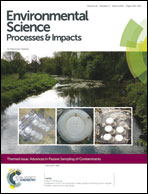Mineral magnetic measurements as a particle size proxy for urban roadside soil pollution (part 1)
Abstract
The use of mineral magnetic concentration parameters (χLF, χARM and SIRM) as a potential particle size proxy for soil samples collected from Wolverhampton (UK) is explored as an alternative means of normalizing particle size effects. Comparison of soil-related analytical data by correlation analyses between each magnetic parameter and individual particle size classes (i.e. sand, silt and clay), more discrete intervals within classes (e.g. fine sand or medium silt) and cumulative size fractions (e.g. clay + fine silt) are reported. χLF, χARM and SIRM parameters reveal significant (p < 0.05; p < 0.001 n = 60), moderate negative (rs = −0.3 to −0.557) associations with clay, silt and sand content. Contrary to earlier research findings which found positive relationships, this indicates that magnetic measurements cannot always provide a predictable particle size proxy and it is only certain environments and/or specific settings that are appropriate for granulometric normalization by this technique. However, if future researchers working in other soil settings can identify a formal predictable relationship, the technique is known to offer a simple, reliable, rapid, sensitive, inexpensive and non-destructive approach that could be a valuable proxy for normalizing particle size effects in soil contamination studies.


 Please wait while we load your content...
Please wait while we load your content...